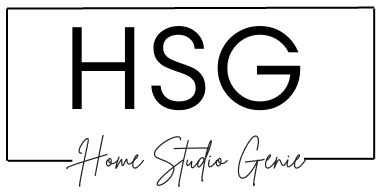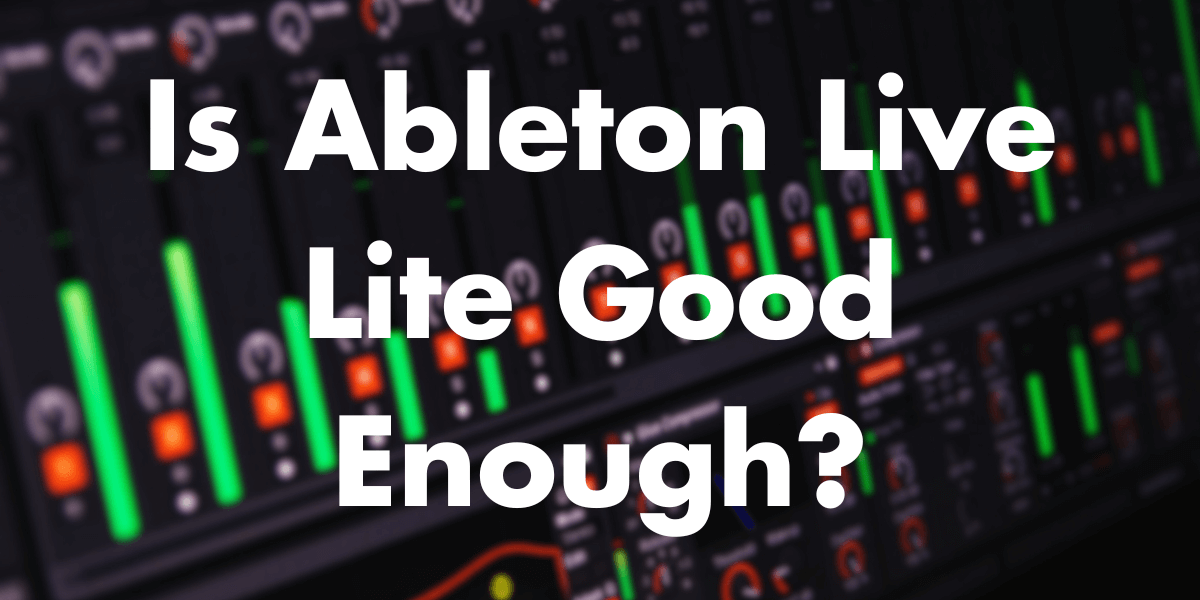Ableton Live Lite is the free version of Ableton’s popular DAW software. Live Lite comes bundled with many MIDI controllers and audio interfaces.
Many producers start with Live Lite before deciding if they want to upgrade to the full version of Live because of this.
But is Ableton Live Lite good enough for most home studio producers? Or should you skip right to the full version of Live?
I will be comparing Live Lite and Live Standard and Suite’s key features in this article. I’ll help you decide if Live Lite has everything you need to start making music.
Or if it’s better to invest in the full Live Standard or Suite right from the start.
Ableton Live Lite vs. Live Standard vs. Live Suite
As of 2024, Ableton has now released Live 12. Ableton Live 12 comes in 3 versions, namely Ableton Live Lite, Standard, and Suite.

Here’s a quick comparison of the key features of each:
Live Lite
- 16 audio tracks
- 8 MIDI tracks
- 12 sends
- 2GB sound library
- 32-bit float audio
- Warping and real-time time-stretching
- 42 audio effects and MIDI effects
Live Standard
- Unlimited audio and MIDI tracks
- 32 sends
- 5GB sound library
- 64-bit float audio
- Sampler instrument
- Arpeggiator MIDI effect
- 70 more audio effects and MIDI effects
Live Suite
Everything in Standard, plus:
- 10GB sound library
- 25 Synths
- 4 instruments
- 61 additional audio effects and MIDI effects
- Max for Live environment
It’s clear that Live Standard and Suite have more features than Live Lite – including more tracks, effects, instruments, sounds, Max for Live, and more.
But does Live Lite still give you enough to get started producing music?
Let’s dig into that next.
Ableton Live Lite Limits for Beginners
Ableton designed Live Lite to give new producers a chance to get started with Live without spending much money. And it succeeds at that goal.
Producing in Live Lite as a beginner:
Plenty of tracks for getting started – The 16 audio and 8 MIDI track limit in Lite gives beginners ample room to sketch out ideas and create full songs. Many pro tracks don’t use more than 16-24 tracks. So you have some room to grow.
Great built-in instruments and effects – Live Lite comes with simplified versions of Live’s amazing instruments like Simpler, Impulse, and Drum Rack. And key audio effects like EQ Eight, Auto Filter, Compressor, and more.
Warping saves time – Live’s warping features let you quickly match vocals and instruments to your project tempo. This saves tons of time pitching and editing recordings.
Easy to learn and use – Live Lite has the same streamlined workflow as the rest of Live. The interface is clean and simple compared to more cluttered DAWs. This makes it easy for beginners to learn.
Live Lite doesn’t feel overly limited for someone just getting started producing their own tracks. The track count, instruments, effects, warping, and interface give you lots of power.
You might also want to look at your system and if it can handle Ableton Live versions. Forunately, Ableton Live works on both PC and Mac.
System requirements for Ableton Live 12:
| System Requirements | Windows | macOS |
|---|---|---|
| Operating System | Windows 10 (version 22H2) or Windows 11 (version 22H2 or higher) | macOS 11 Big Sur or higher |
| Processor | 5th generation Intel® Core™ i5 or AMD Ryzen (supports AVX2 instruction set) | Intel® Core™ i5 or Apple Silicon |
| RAM | 8 GB | 8 GB |
| Display Resolution | 1366×768 | 1280×800 |
| Audio Interface | ASIO-compatible audio hardware recommended | Core Audio compliant audio interface recommended |
| Disk Space | ~3 GB for installation (8 GB recommended); up to 76 GB for additional content | ~3 GB for installation (8 GB recommended); up to 76 GB for additional content |
Keep in mind that just because these requirements are met by your setup, it doesn’t guarantee you’ll have no problems with Ableton Live.
This is because, along the way, you might need to install third-party plugins and connect hardware.
What Beginners May Miss in Ableton Live Lite
However, once you start getting more experienced, you may find Live Lite a bit restricting.

Here are some things you’ll wish you had:
- More tracks – 16 tracks limit how many instruments and elements you can add to your projects. Making bigger, layered productions starts to get tight.
- More effects – With only 42 effects in Lite, you’ll miss out on many processing options for mixing and sound design compared to Standard or Suite.
- Better instruments – Live’s Sampler instrument in Standard and Suite is far more advanced than Lite’s Simpler. Access to Live’s synths and other instruments is also limited.
- Max for Live – This cool environment for building instruments and effects is only in Suite.
To sum it up, Ableton Live Lite is an excellent starting point for beginners. But more serious producers will quickly run into limitations.
Unless you plan to stay a bedroom hobbyist, it’s smart to consider Standard or Suite early on.
Ableton Live Lite for EDM Producers
EDM styles like house, techno, trance, and others are hugely popular with Live users. Does Live Lite offer enough to produce professional EDM tracks?

Or do you need a Standard or Suite package?
In general, I think Live Lite will start feeling quite limited for EDM producers pretty quickly. Here’s why:
More tracks are needed. Most EDM relies on layering parts, such as basses, leads, pads, arps FX, and more. 16 tracks make this difficult. Getting ideas down requires compromising parts.
Limited effects – EDM production heavily uses effects – compression, saturation, reverb, delay and more. Live Lite doesn’t offer enough.
Need more instruments – EDM producers need solid synths and bass instruments. Live Lite only has 1 basic synth and sampler.
Lacks Max – Max for Live opens up infinite creative possibilities – custom synths, effects, sequencers and more. No Max in Lite.
So while Live Lite will let you sketch out basic EDM track ideas, finishing songs will be frustrating. The limitations will kill creativity and quality.
For EDM, I strongly suggest upgrading to Live Standard or Suite sooner rather than later. The unlimited tracks and large instrument and effect selection will be game-changing coming from Lite.
Table comparing key differences between Live Lite vs Standard vs Suite:
| Feature | Live Lite | Live Standard | Live Suite |
|---|---|---|---|
| Audio Tracks | 16 | Unlimited | Unlimited |
| MIDI Tracks | 8 | Unlimited | Unlimited |
| Send Tracks | 12 | 32 | 32 |
| Sound Library Size | 2GB | 5GB | 10GB |
| Bit Depth | 32-bit float | 64-bit float | 64-bit float |
| Instruments | Simpler, Impulse, Drum Rack | + Sampler, Arpeggiator | + Synths, Instruments |
| Effects | 42 | +70 more | +61 more |
| Max for Live | No | No | Yes |
Ableton Live Lite for Singer-Songwriters
Next, let’s look at Live Lite for solo artists writing songs at home. This includes genres like folk, indie, acoustic and pop.

Does Ableton Live Lite offer enough for basic home recording and production?
Live Lite provides all the essential elements for singer-songwriters to write and record quality demos and simple productions.
- Record vocals and acoustic instruments easily with the 16 tracks.
- Use Simpler to map vocals and acoustic instruments across keys.
- Use Impulse reverb on vocals and guitars to simulate real spaces.
- Shape vocal and instrument sounds with EQ Eight and Compressor.
- Mix using Lives’ intuitive interface.
Nonetheless, there’s a chance you’d like more:
- 16 tracks limit instruments and vocal layers you can add.
- Standard and Suite offer nicer reverbs like Convolution Reverb for ultra-realistic spaces.
- Tools like Harmony Engine for advanced vocal thickening.
- More MIDI instruments in Standard and Suite for strings, keys, etc.
So while Live Lite hits the core needs of solo artists, upgrading down the road will open more creative possibilities. The track limitations in Lite will eventually be frustrating.
But for just recording demos and rough productions, Lite has all the recording, editing and mixing power most indie artists need.
Start with Ableton Live Standard or Suite
If you know you want to get serious about production, it’s smart to invest in Live Standard or Suite from the start instead of beginning with Lite.
Here are some key benefits starting with Standard or Suite gives you:
No track limitations – Starting with unlimited tracks prevents creative frustration down the road. You can add as many instruments and elements as your projects demand.
More effects – The huge library of effects in Standard and Suite expands your mixing, sound design and creative options tremendously compared to Lite.
Better instruments – Access to Live’s Sampler, synths, Drum Synths and instruments like Strings let you achieve more professional results right away.
Room to grow – Standard and Suite have all the features and polish needed for truly pro-level productions. Beginners have lots of room to improve their skills over time.
Saves money – Upgrading from Lite to Standard or Suite later costs extra money. Starting with the full versions saves cash.
The only potential downside of skipping Lite is that Standard and Suite are more complex. Their deep features have steeper learning curves for absolute beginners.
But with free tutorials on YouTube, the Live manual, and linked Guide chapters built into Live, new users can get up to speed with Standard and Suite quickly.
Their expanded features will likely inspire beginners more than limit them.
Final Thoughts – Is Ableton Live Lite Good Enough?
To close up, while Ableton Live Lite may have its limitations, it is undeniably a powerful and accessible tool for music production. Whether you’re a beginner or a seasoned producer, Live Lite offers a solid foundation for creating professional-sounding tracks.

With its intuitive interface, versatile editing capabilities, and plugin support, it is undoubtedly good enough for most music production needs. So why not give it a try and see where your creativity takes you?
Before deciding if Ableton Live Lite is good enough for you, consider your specific music production needs, budget, and long-term goals.
If you’re just starting and looking for a cost-effective way to learn the basics of music production, Ableton Live Lite can be a great option.
On the other end, if you have more advanced production requirements, you may need to consider upgrading to a higher-tier version of Ableton Live to fully meet your needs.

April holds both a Master’s Degree and a Bachelor’s Degree in Sound Recording, and has over 15 years experience in the field. April works primarily as a re-recording mixer and sound editor (based in Los Angeles), but also has experience as a music editor and mixer, and ADR and Foley engineer.


